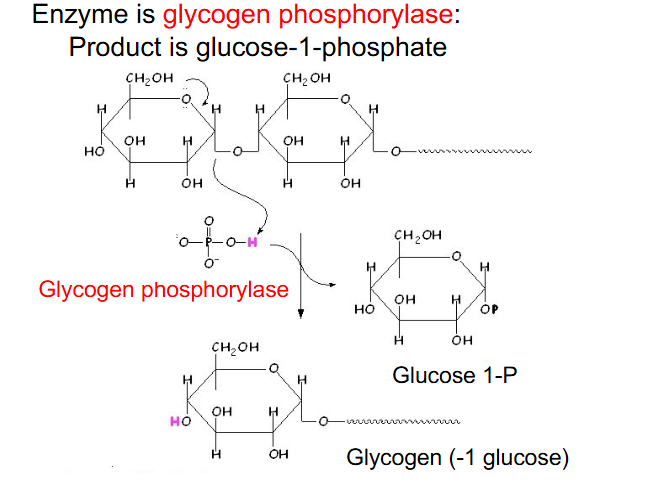IMED1003 - Gluconeogenesis and Glycogen Metabolism (L13)
1/23
There's no tags or description
Looks like no tags are added yet.
Name | Mastery | Learn | Test | Matching | Spaced |
|---|
No study sessions yet.
24 Terms
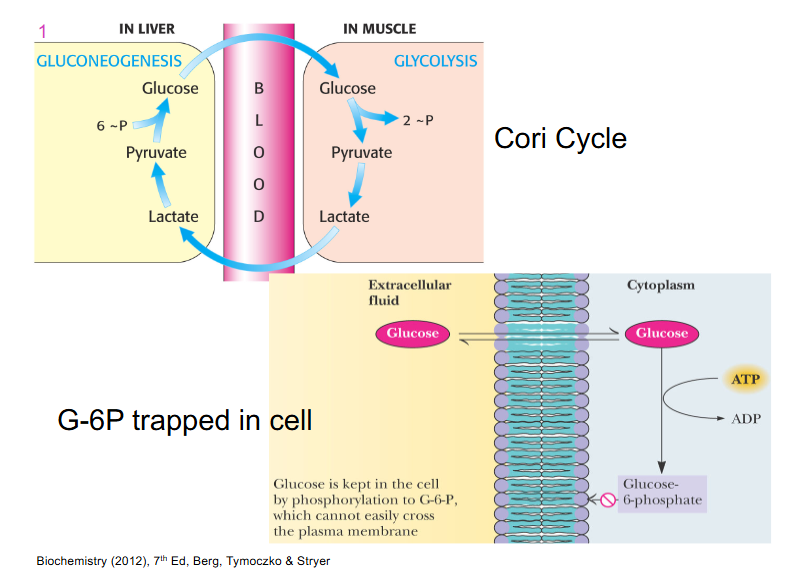
What we've done so far
DIAGRAM ON SLIDE 3
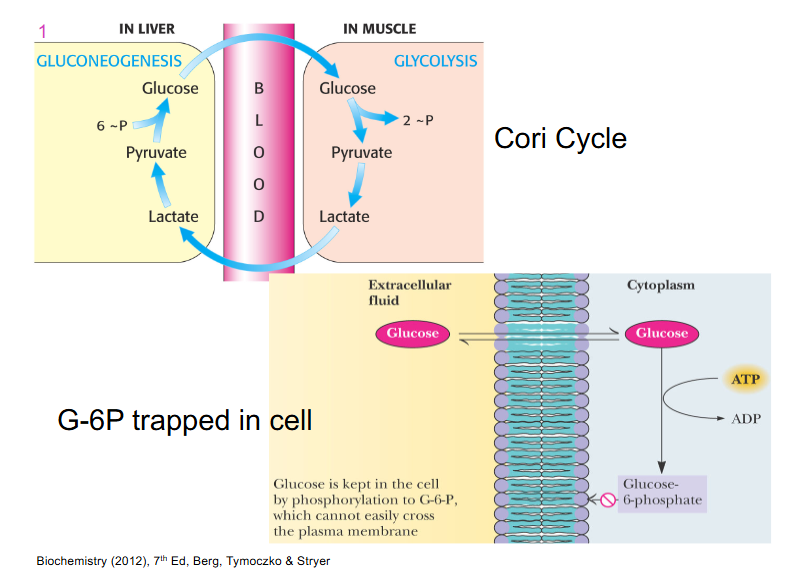
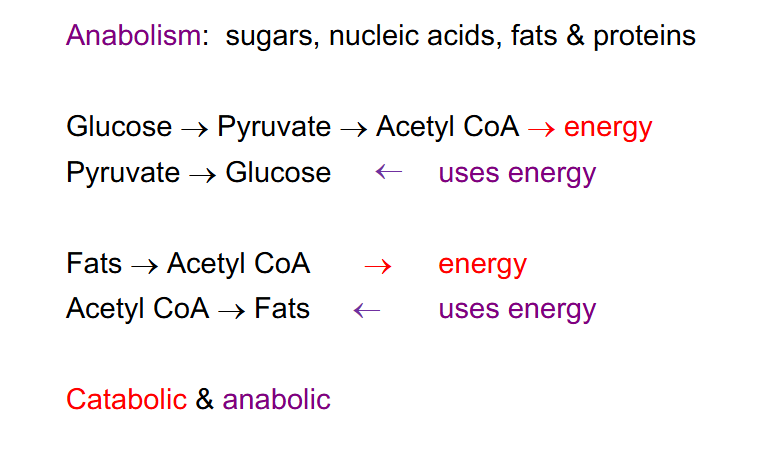
Biosynthesis of Macromolecules
Anabolism: sugars, nucleic acids, fats, proteins
.
- Glucose -> Pyruvate -> Acetyl CoA -> energy
- Pyruvate -> Glucose (uses energy)
.
- Fats -> Acetyl CoA -> energy
- Acetyl CoA -> Fats (uses energy)
.
Red is catabolic, purple is anabolic
- catabolic processes are energy yielding, anabolic is energy requiring
.
- glycolysis and gluconeogenesis are opposites, they do not occur at the same time within the same cell
- the liver cell that is producing the glucose cannot undergo glycolysis at the same time
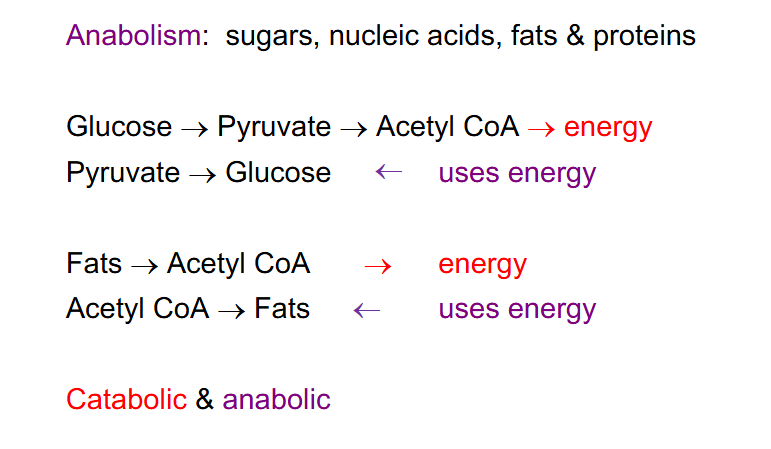
Gluconeogenesis
- Net synthesis of "new glucose"
- NOT glycogen -> glucose (glycogenolysis - catabolic)
- Need around 160g-200g glucose per day (3/4 used by CNS)
- Body fluids contain only 5-10g glucose
- Glycogen stores yield around 180-200g glucose depleted after a day or so
- Body must make new glucose
- over 90% of gluconeogenesis occurs in liver and kidneys.
.
DONT need to remember the numbers here, only need to remember that for a 70kg adult healthy male we need around 160 to 200g of glucose per day
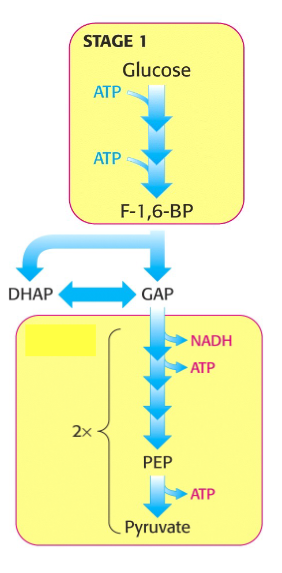
Gluconeogenesis process
- Reverse of glycolysis except: uses 7 of the 10 enzymatic reactions of glycolysis but in reverse direction
- 3 not used
- 3 key irreversible reactions and are the 3 key regulatory steps of glycolysis
- Therefore require other enzymes to bypass these reactions to produce glucose from pyruvate
.
- the reason gluconeogenesis can't occur in all tissues is because not all tissues have the specific enzymes to reverse process of glycolysis, liver does have it (remember that the irreversible steps cant be reversed normally, needs specific new enzymes)
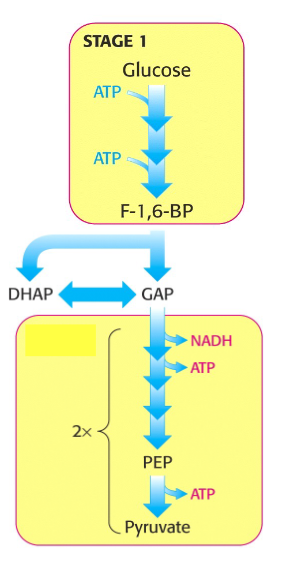
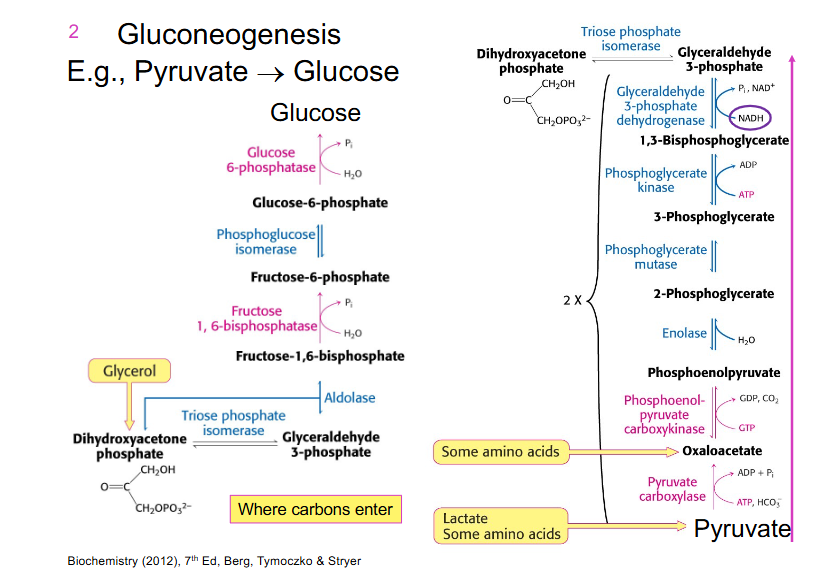
Gluconeogenesis process diagrams
Pyruvate -> Glucose
3 control points of glycolysis:
- hexokinase, phosphofructokinase (PFK), and pyruvate kinase
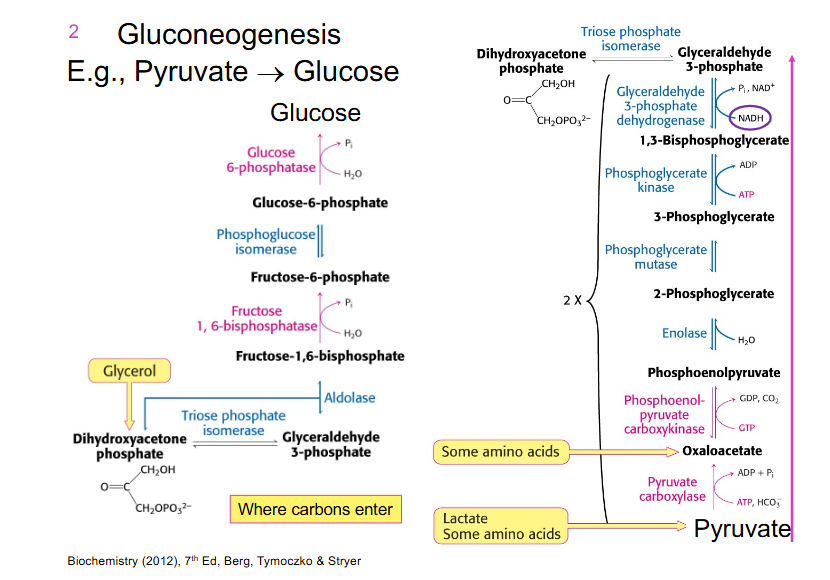

Gluconeogenesis Equations
- 2 pyruvate + 4ATP + 2GTP + 2NADH + 2H+ + 4H2O -> Glucose + 4ADP + 2GDP + 6Pi + 2NAD+ (Delta G is -16kJ/mol)
- IF simply reverse of glycolysis under same conditions (Delta G = +63kJ/mol, dont need to remember the number)
- So, need energy input (6ATP equivalents is what you need to know) (ATP helps drive energetically unfavourable reactions)
- Only 2 ATP gained in glycolysis
- extra ATP comes from fatty acid breakdown

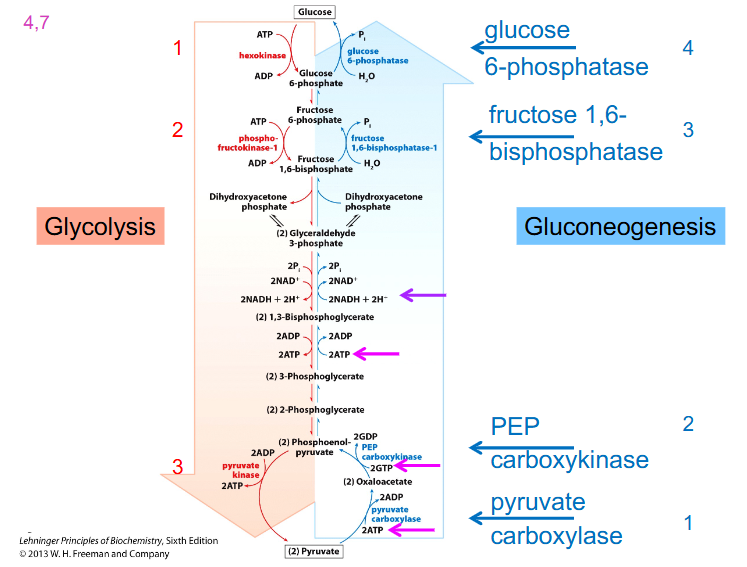
Gluconeogenesis and Enzymes
Irreversible Glycolytic Enzymes:
1. Hexokinase
2. Phosphofructokinase 1
3. Pyruvate Kinase
.
Extra (bypass) enzymes of gluconeogenesis:
1. Pyruvate carboxylase (ATP) - mitochondria
2. Phosphoenolpyruvate carboxykinase (GTP) - cytosol
3. fructose 1,6-bisphosphatase - cytosol
4. glucose 6-phosphatase - endoplasmic reticulum
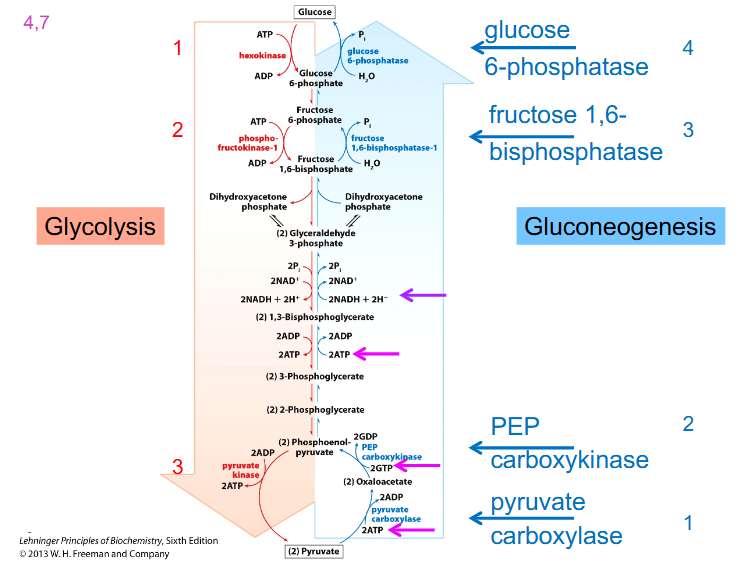
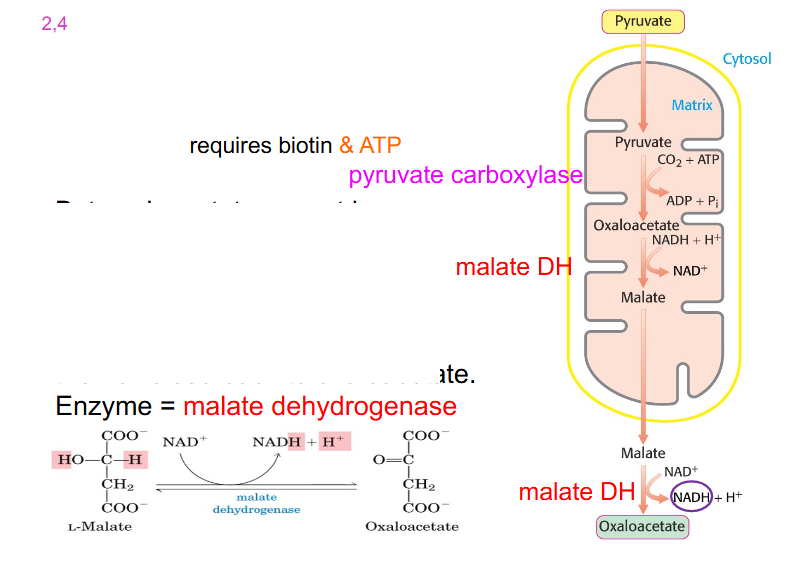
Pyruvate converted to oxaloacetate in mitochondrial matrix
- pyruvate converted to oxaloacetate in mitochondrial matrix
- Enzyme = pyruvate carboxylase (requires biotin and ATP)
- But oxaloacetate cannot be transported directly across mitochondrial membrane.
- so it is converted to malate, transported out of the mitochondria, then oxidised back to oxaloacetate
- Enzyme: malate dehydrogenase
.
- note that the reaction to convert oxaloacetate to malate takes NAD+ and turns it into NADH and H+
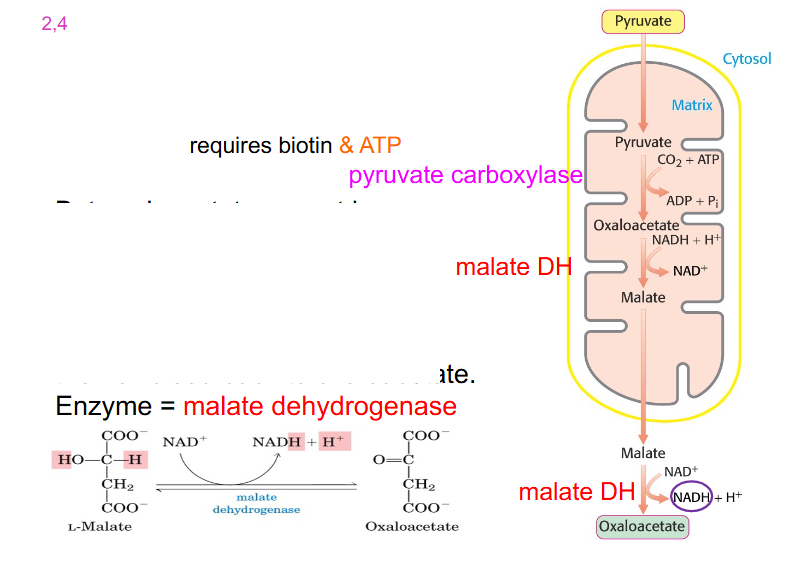
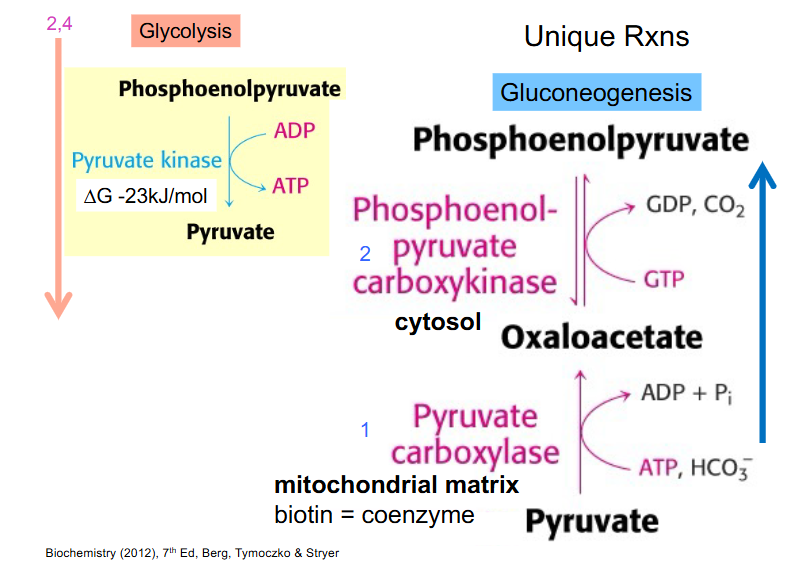
2nd enzyme that reverses pyruvate kinase reaction
- phosphoenolpyruvate carboxy kinase
- Converts oxaloacetate thats now within the cytosol to phosphoenolpyruvate (requires GTP)
- we go from 4 carbon OAA to 3 carbon phosphoenolpyruvate (we've cleaved off that carbon that we added in the mitochondria
- remember that both of these enzymes are reversing this irreversible step of glycolysis (pyruvate kinase) (large negative delta G, hence irreversible)
PEP is phosphoenolpyruvate
.
The two enzymes that provide an alternative pathway for the pyruvate kinase reaction in gluconeogenesis are pyruvate carboxylase and phosphoenolpyruvate carboxykinase (PEPCK). Pyruvate carboxylase converts pyruvate to oxaloacetate, and then PEPCK converts oxaloacetate to phosphoenolpyruvate, effectively bypassing the irreversible step catalyzed by pyruvate kinase in glycolysis.
Detailed Steps:
Pyruvate Carboxylase:
This enzyme uses ATP to add a carboxyl group to pyruvate, forming oxaloacetate.
Phosphoenolpyruvate Carboxykinase (PEPCK):
This enzyme then converts oxaloacetate into phosphoenolpyruvate (PEP) using GTP.
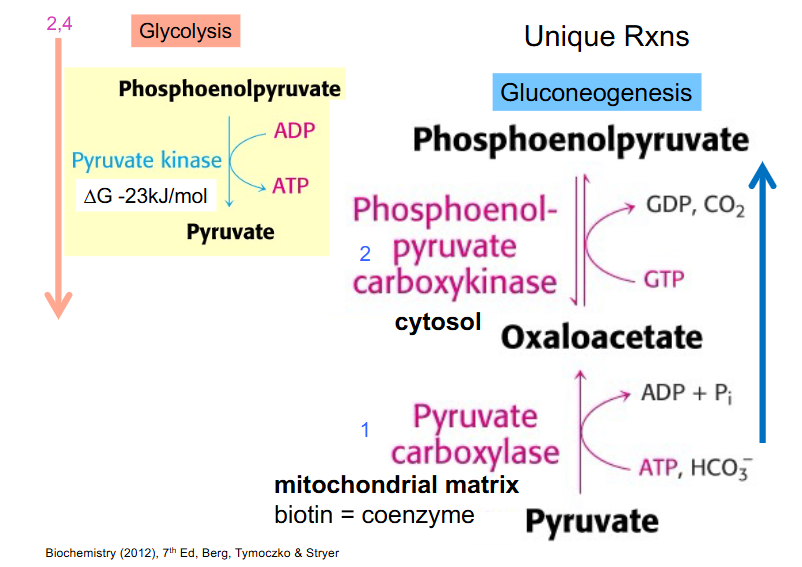
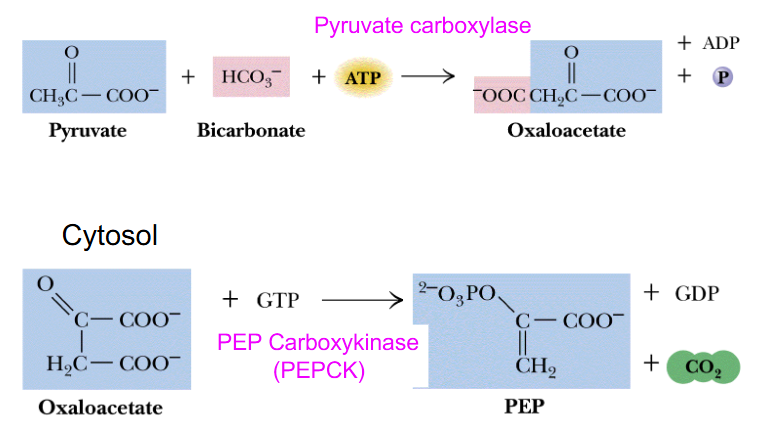
Summary of Reaction of Pyruvate to OAA and OAA to PEP
DIAGRAM ON SLIDE 13
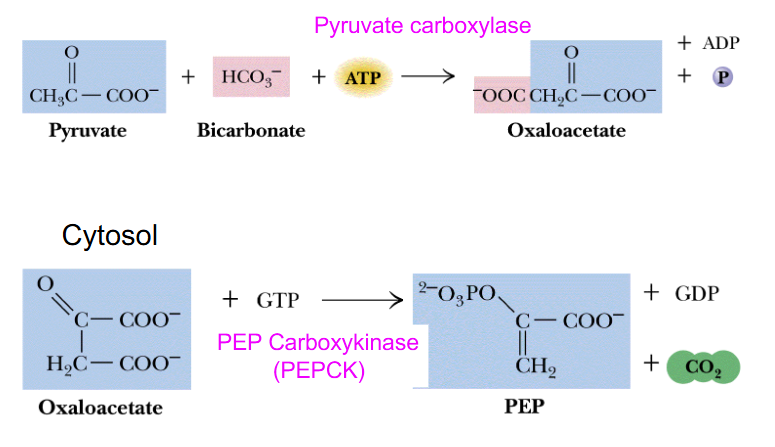
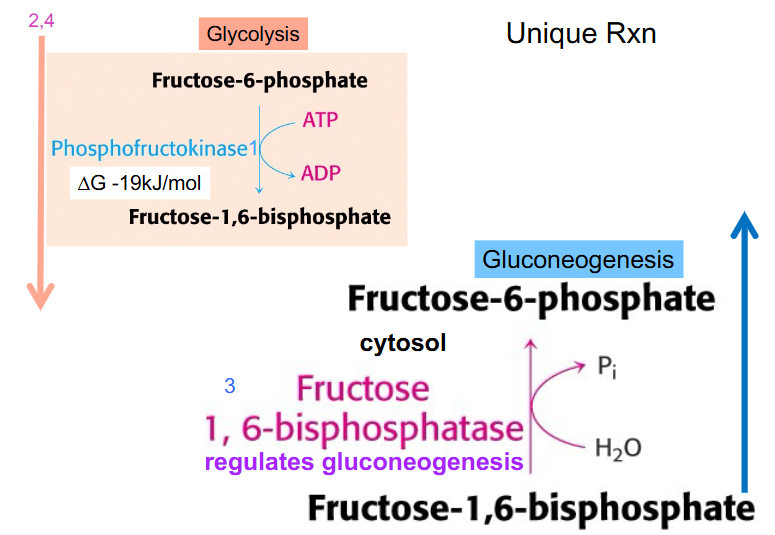
Next irreversible reaction in glycolysis: Phosphofructokinase-1
- We have an enzyme called fructose-1,6-bisphosphotase which can strip off the phosphate from fructose-1,6-bisphosphate and give us fructose 6 phosphate
- this is the main regulatory enzyme in gluconeogenesis
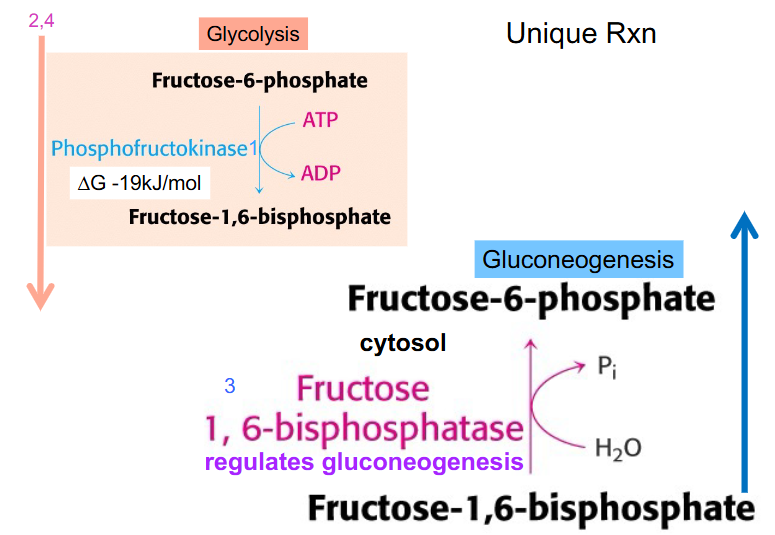
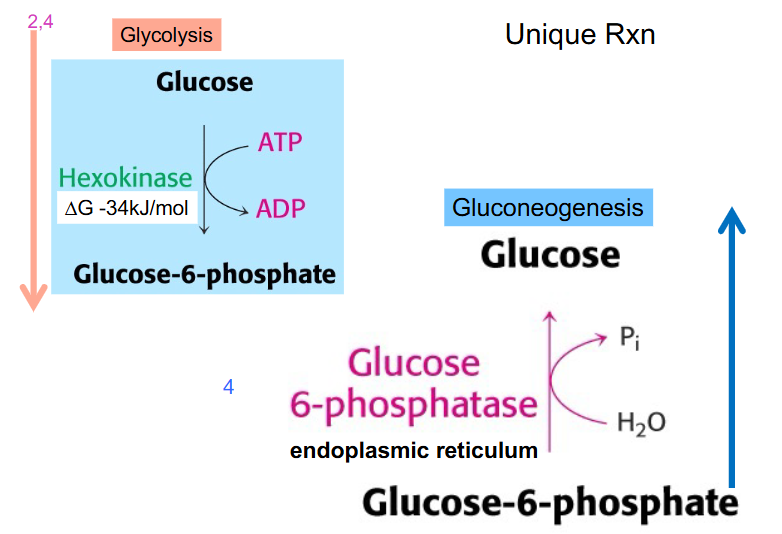
Final reaction in gluconeogenesis to reverse: Hexokinase
- Glucose 6-phosphate is converted to glucose
- occurs in endoplasmic reticulum
- Glucose-6-phosphotase causes conversion of glucose-6-phosphate to glucose
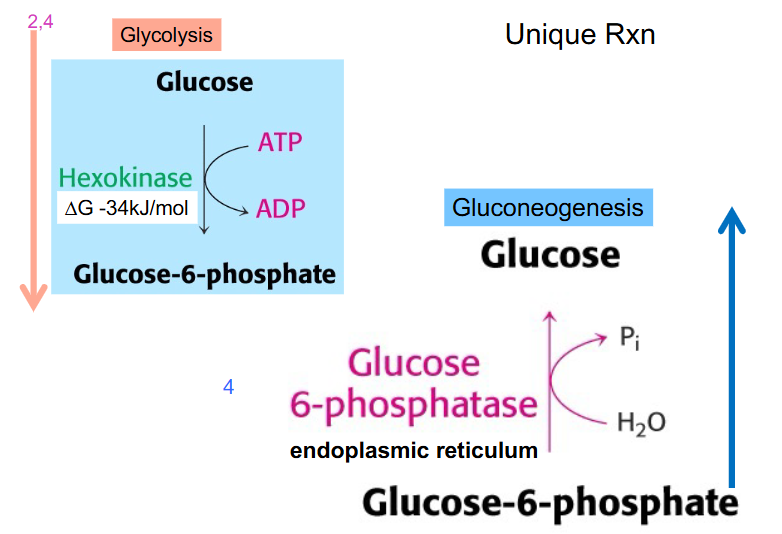
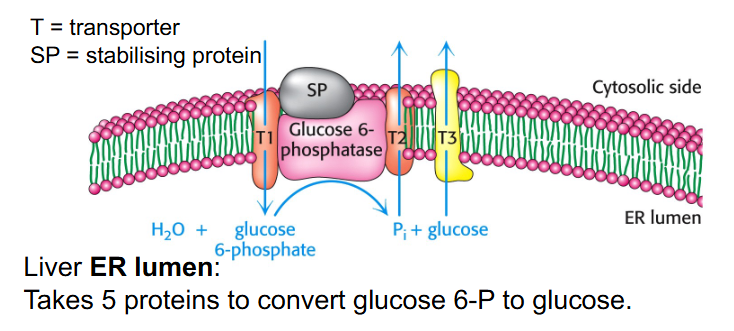
Glucose 6-phosphotase
- Present in only tissues responsible for maintaining [blood glucose] = liver and kidney
- In liver, glucose 6-phosphotase subject to substrate level control - at higher [G6P] reaction rate increases
.
- Liver ER Lumen: Takes 5 proteins to convert Glucose 6-P to glucose
.
- The transporters transport Glucose 6-phosphate to the lumen side, and stabilising protein stably embeds G6P within ER
- second transporter transports cleaved Pi (inorganic phosphate) back out
![<p>- Present in only tissues responsible for maintaining [blood glucose] = liver and kidney</p><p>- In liver, glucose 6-phosphotase subject to substrate level control - at higher [G6P] reaction rate increases</p><p>.</p><p>- Liver ER Lumen: Takes 5 proteins to convert Glucose 6-P to glucose</p><p>.</p><p>- The transporters transport Glucose 6-phosphate to the lumen side, and stabilising protein stably embeds G6P within ER</p><p>- second transporter transports cleaved Pi (inorganic phosphate) back out</p>](https://knowt-user-attachments.s3.amazonaws.com/2e6942bb-6047-4fee-a445-294e202db79d.png)
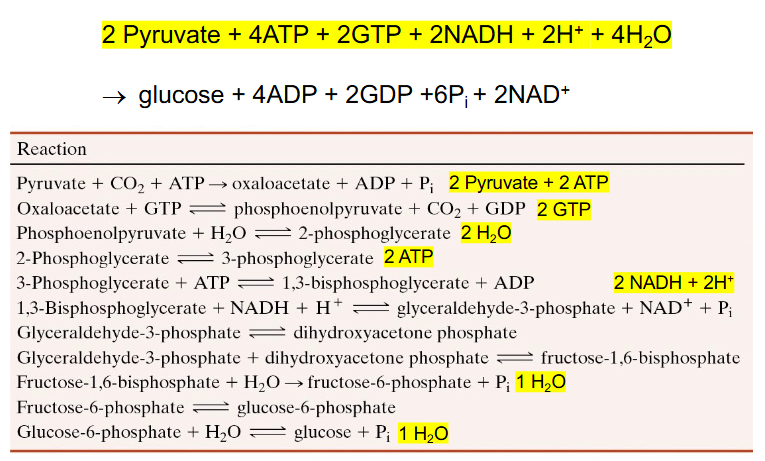
OVERALL REACTION OF ABOVE STEPS
- only need to know the overall reaction
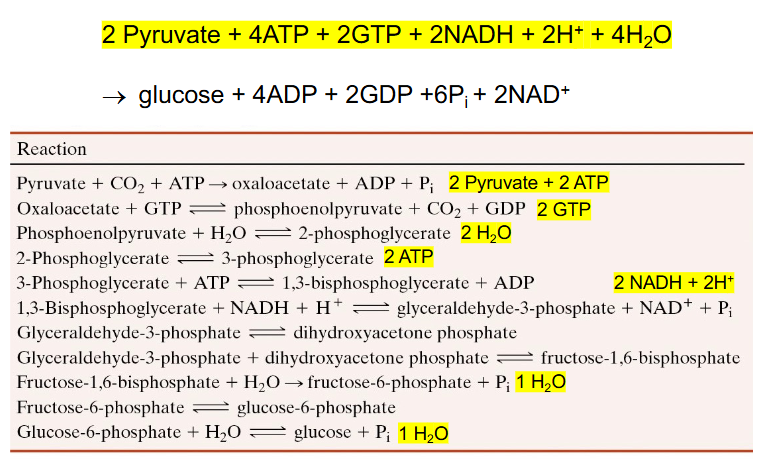
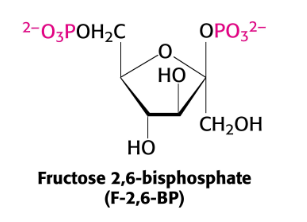
Regulation of Gluconeogenesis
- Glycolysis and gluconeogenesis reciprocally regulated (catabolism and anabolism, if you inhibit one you activate the other)
- molecules that inhibit gluconeogenesis often activate glycolysis, and vice versa
- This includes hormones
.
Fructose 2,6-bisphosphate:
- Potent allosteric regulatory molecule
- activates phosphofructokinase 1
- inhibits fructose-1,6-bisphosphotase
Thus, activates glycolysis and inhibits gluconeogenesis, so [F-2,6 BisP] very important
.
- basically high levels of Fructose 2,6-Bisphosphate turns on glycolysis through phosphofructokinase 1 and inhibits fructose-1,6-bisphosphatase
- remember that both these enzymes are cytosolic and they only work uniquely in one pathway or the other
![<p>- Glycolysis and gluconeogenesis reciprocally regulated (catabolism and anabolism, if you inhibit one you activate the other)</p><p>- molecules that inhibit gluconeogenesis often activate glycolysis, and vice versa</p><p>- This includes hormones</p><p>.</p><p>Fructose 2,6-bisphosphate:</p><p>- Potent allosteric regulatory molecule</p><p>- activates phosphofructokinase 1</p><p>- inhibits fructose-1,6-bisphosphotase</p><p>Thus, activates glycolysis and inhibits gluconeogenesis, so [F-2,6 BisP] very important</p><p>.</p><p>- basically high levels of Fructose 2,6-Bisphosphate turns on glycolysis through phosphofructokinase 1 and inhibits fructose-1,6-bisphosphatase</p><p>- remember that both these enzymes are cytosolic and they only work uniquely in one pathway or the other</p>](https://knowt-user-attachments.s3.amazonaws.com/6605e25a-f50a-4b90-ab0b-91eeaaa6b528.png)
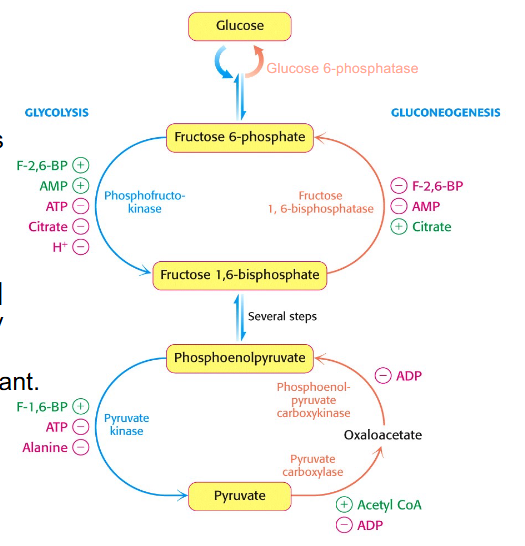
Regulation
High [AMP] indicates cell's energy charge low and signals need for ATP
- High [ATP] and [citrate] indicates cell's energy charge high and intermediates abundant
![<p>High [AMP] indicates cell's energy charge low and signals need for ATP</p><p>- High [ATP] and [citrate] indicates cell's energy charge high and intermediates abundant</p>](https://knowt-user-attachments.s3.amazonaws.com/12e2e48a-95d8-43d8-8dc2-a218c1044c20.png)
Gluconeogenesis Substrates vs NOT substrates
- Net synthesis or formation of glucose from various substrates = gluconeogenesis
SUBSTRATES:
- Pyruvate - & molecules that can be converted into pyruvate
- so Lactate is one that can be converted to pyruvate
- TCA intermediates can be converted to pyruvate (amphibolic = both anabolic and catabolic)
.
- Glycerol (can be converted into an intermediate
- most amino acids
- galactose and fructose (if a sugar can enter glycolysis, it can be used to form glucose)
.
NOT substrates:
- Acetyl CoA (only 2 carbons, no good)
- Fatty Acids (broken down into 2 carbon Acetyl CoA, no good)
- Lysine and Leucine (these two specifically cannot be made into glucose, breakdown of these yields acetyl CoA, not good)
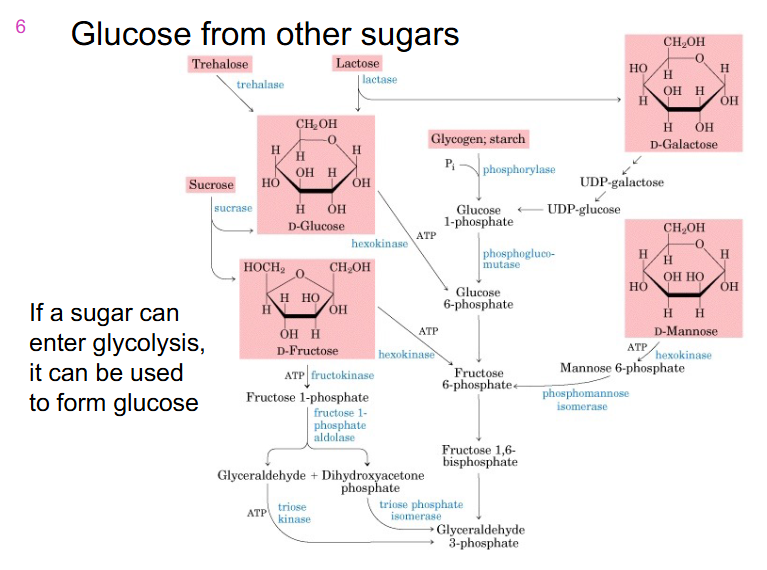
Glucose from other sugars
- if a sugar can enter glycolysis, it can be used to form glucose
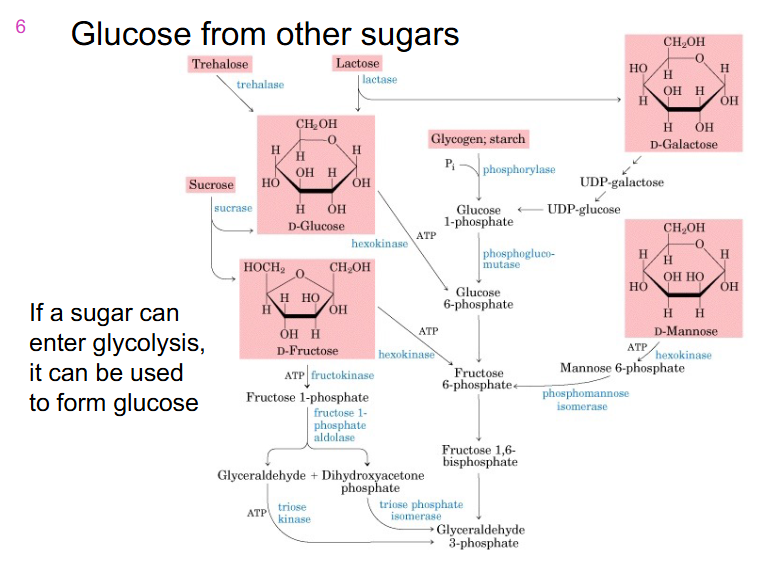
Lactate and Alanine are Glucogenic
- Glucogenic = can be metabolised into glucose
- in active muscle lactate builds up, passes through the blood and is converted to pyruvate in the liver
- So, part of the metabolic burden of active muscle is shifted to the liver
- in muscle alanine is produced from pyruvate by transamination (later lecture):
- pyruvate + glutamate <--> alanine + alpha-ketoglutarate
- In the liver, alanine is converted back to pyruvate
Glucose from other amino acids
- AA are glucogenic or ketogenic (cannot be metabolised to glucose), or both
- All but leucine and lysine are partially glucogenic
- Aromatic AA are glucogenic and ketogenic
.
- Catabolism of glucogenic AA -> net pyruvate or net oxaloacetate - can enter gluconeogenesis
- Leucine and lysine are ketogenic not glucogenic
- Leu and Lys -> Acetyl CoA -> ketone bodies
**Acetyl CoA CANNOT be converted to Glucose**
- the reason Acetyl CoA cannot be converted to Glucose is because it only contains 2 carbons
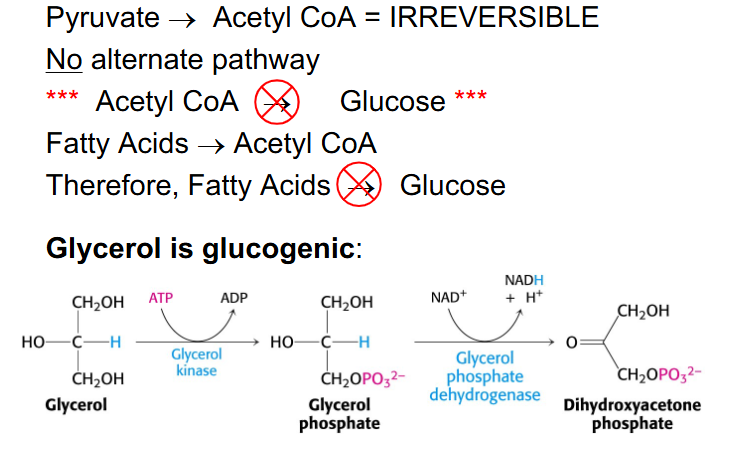
Glucose from Fats
- Pyruvate -> Acetyl CoA = IRREVERSIBLE
NO alternate pathway
**Acetyl CoA -/-> Glucose** (the slash means it will not happen)
- Fatty acids -> Acetyl CoA
- Therefore fatty acids will not make glucose
- Glycerol is glucogenic
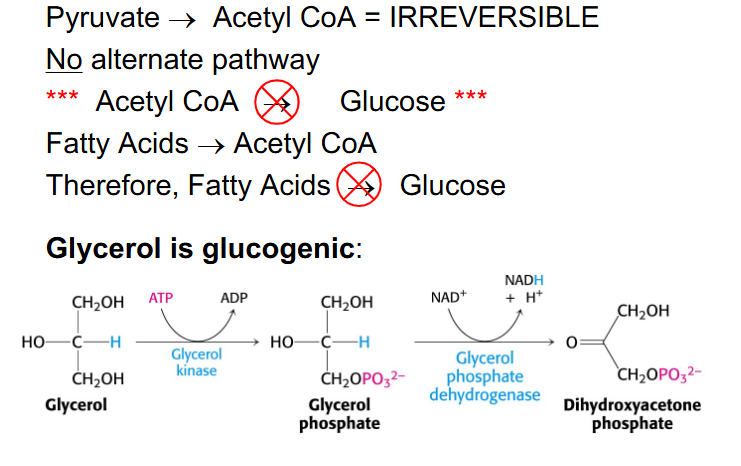
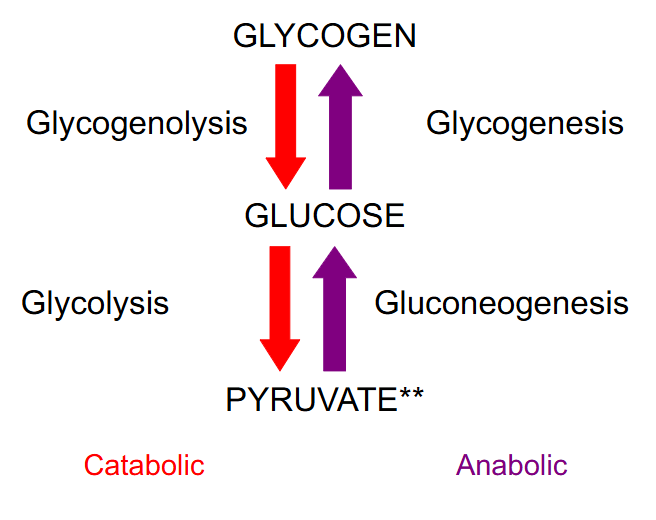
Storage and Release of Glucose
- Glycogen is branch chain glucose, storage molecules for glucose found in many cells
- Glycogenolysis releases one glucose one at a time
- When we build up glycogen, the process is called glycogenesis and we build it up one at a time
- the glucose attach to a molecule called glycogenin. we need to have a few glucose attached to glycogenin before you can start to build up more and more glucose as glycogen stores
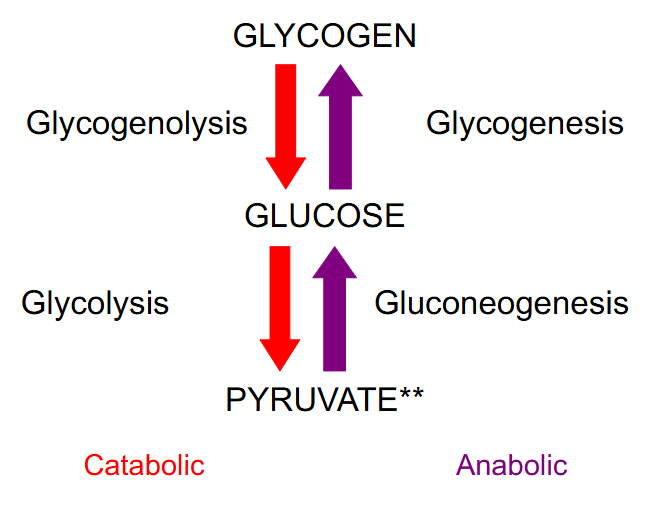
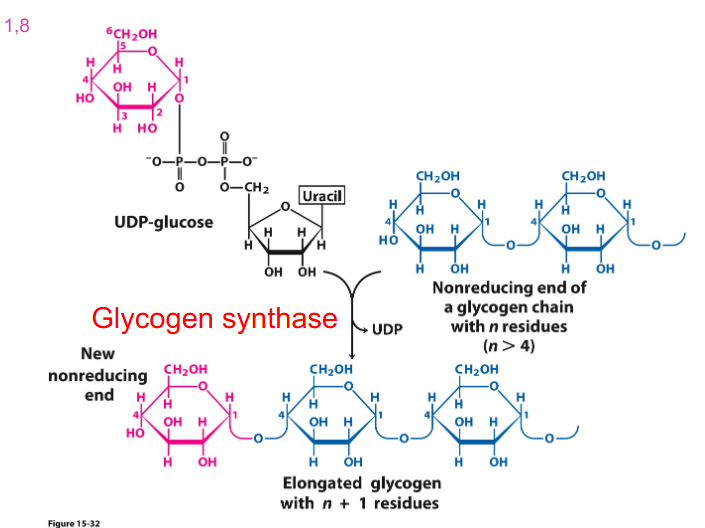
Glycogen Synthesis
- Key enzyme is Glycogen synthase
- that enzyme actually requires activated glucose.
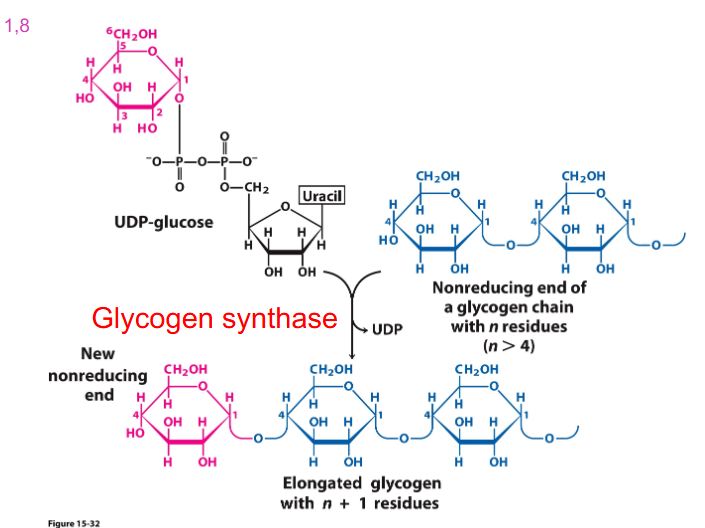
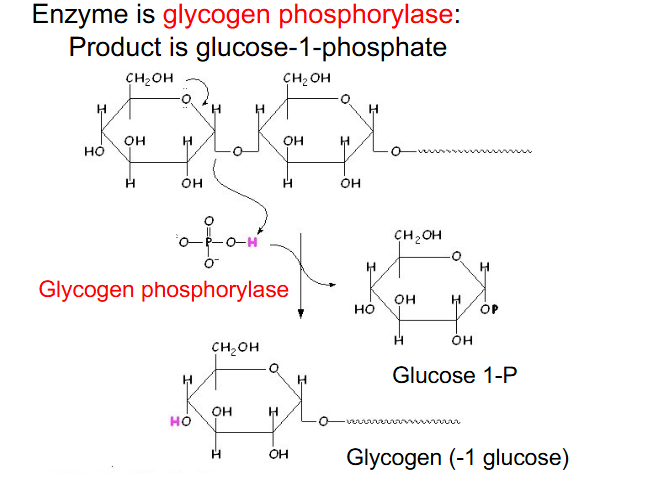
Glycogenolysis
- catabolism to yield glucose
- enzyme is glycogen phosphorylase: Product is glucose-1-phosphate
- we remove glucose as phosphorylated glucose one at a time
